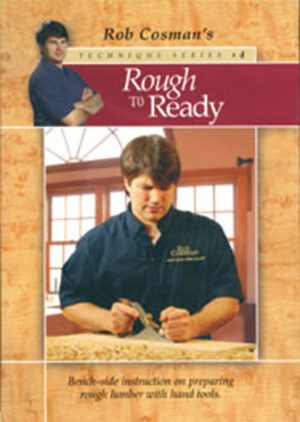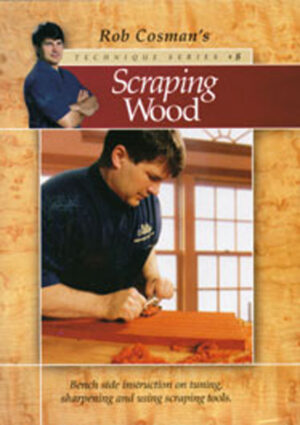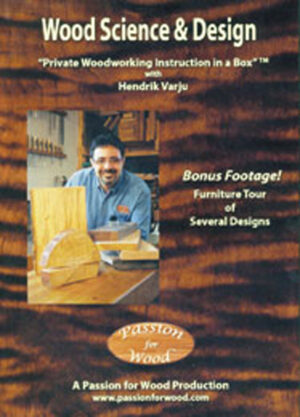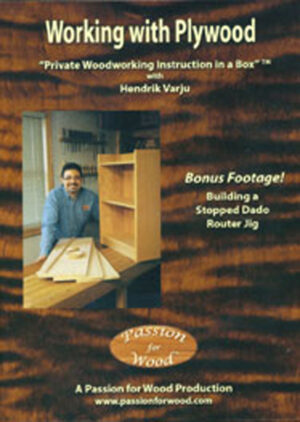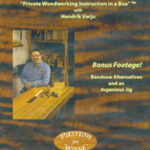HANDCUT DOVETAILS DVD
$110.00
Private Woodworking Instruction in a Box
with Hendrik Varju
Produced by Passion for Wood, Ontario, Canada
ISBN 978-0-9881280-6-4
As reviewed in The Australian Woodworker Issue 185
One of the remarks made by Varju in this video sticks in the memory. It’s a comment about the quality of dovetail joints found in antique furniture. He points out that they are often nowhere near as well made as those in the furniture produced by today’s leading woodworkers.
Of course, we have every right to marvel at the work of the masters who made the furniture treasures that have lasted through hundreds of years. We know that they were created entirely by hand and can hardly imagine what it must have been like to take boards roughly milled with huge handsaws and convert them to a precisely flat and superbly polished table top large enough to serve a dozen diners – all with hand tools and no power other than that which could be derived from their own bodies.
But we shouldn’t lose sight of the fact that they made their furniture for sale. It had to be sturdy, presentable and able to be produced at a price their customers could afford.
The bespoke furniture makers of today work within similar constraints, though there are differences. They have machines to do much of the heavy work for them, but it is arguable that they must now meet, if anything, higher standards of workmanship than were acceptable a few centuries ago.
The dovetail joint is not merely used for its strength as it was in furniture of two or three centuries ago. Then, it was not exposed to view (as it may be now), but employed to withstand the forces imposed on a drawer being continually pushed and pulled over decades of use.
Today, it is also used for its beauty. But there are many more jointing options – less expensive options – now available for the construction of contemporary furniture. So there is a significant additional cost involved when a customer wants the drawers in a cabinet or table to be made with dovetails.
However, when this choice is agreed between customer and maker, there is almost always the automatic expectation that the dovetails will be immaculate.
In the course of the presentation on these videos, Hendrik Varju makes clear that it is not his intention to simply teach his viewers how to make dovetail joints – but instead, how to make immaculate dovetail joints.
The videos begin with a discussion about the equipment that is required and the planning necessary to lay out dovetails so that they not only serve their physical purpose, but also appear as attractive as possible within their environment.
This freedom of placement is not given to any but the most expensive of router based methods of dovetail construction so it is still largely the prerogative of the hand dovetail maker.
Varju’s instruction in actually making dovetails starts with what may be seen as the easiest part, the making of the Tails.
For those who have already experienced this presenter’s quiet, relaxed style, there will be no surprises here. He goes about the task of teaching his viewers in the same way as on all of his other videos – with care, precision and the expectation that his student wishes to achieve the highest standards of workmanship.
Like many Western woodworkers, Hendrik Varju has adopted the Japanese Dozuki, a rib-backed, hard-toothed saw that cuts on the pull stroke to make a fine kerf. He shows how to use this saw in the cutting of Tails, offering along the way, the benefits of his experience in the setting up of the workpiece to perform this operation quickly and accurately.
This is followed by the task of chopping the Tails with a chisel and then tracing the Tails onto the Pin board.
Again the Pins are cut with a Dozuki before chiselling away the waste.
This is one of the most significant parts of the whole demonstration since it focusses on the meticulous techniques that Varju has developed to ensure accuracy. This includes a method of mounting the workpiece so as to provide a guide for the chisel and the use of specific chisel movements to completely clear the volume of waste without losing even a sliver of wood that must be retained.
While the use of covering such a mistake by filling with glue and sawdust is mentioned, it is obvious that this is regarded as an unacceptable outcome of the work.
The penultimate sessions are devoted to fitting the Pin and Tail boards and the hand planing of the finished joint.
The final session describes the application of techniques similar to those already covered, to the making of Half Blind Dovetails.
The Bonus Footage on these videos extends the discussion to the use of the bandsaw in making dovetails. While not recommended for small joints, this method of construction is useful when the boards are very thick.
There is also a comprehensive description of the construction and use of a dovetail making jig. This is Hendrik Varju’s own design and offers not only an alternative to the methods described in the body of the videos, but also further insights into the general subject of dovetail making.
As usual, Hendrik Varju has added some philosophical afterthoughts. Here, they reflect on topics such as hand tools and the pursuit of perfection.
Handcut Dovetails will appeal to any woodworker, regardless of experience, who has not yet mastered the intricacies of making these joints. While reasonable skill with a chisel is advisable, the methods shown here will be helpful in reducing reliance upon skill alone – but they still demand the sharpest possible tools!
Handcut Dovetails
– Learn to plan and mark out handcut dovetails
– Master both through and half-blind dovetails
– Learn correct techniques with dozuki saw and chisels
– Master final fitting and hand planing of the finished joint
– Build a jig to help you cut dovetails by hand
Duration: 6hrs, 58 mins, 4 discs
DVD – English – NTSC

